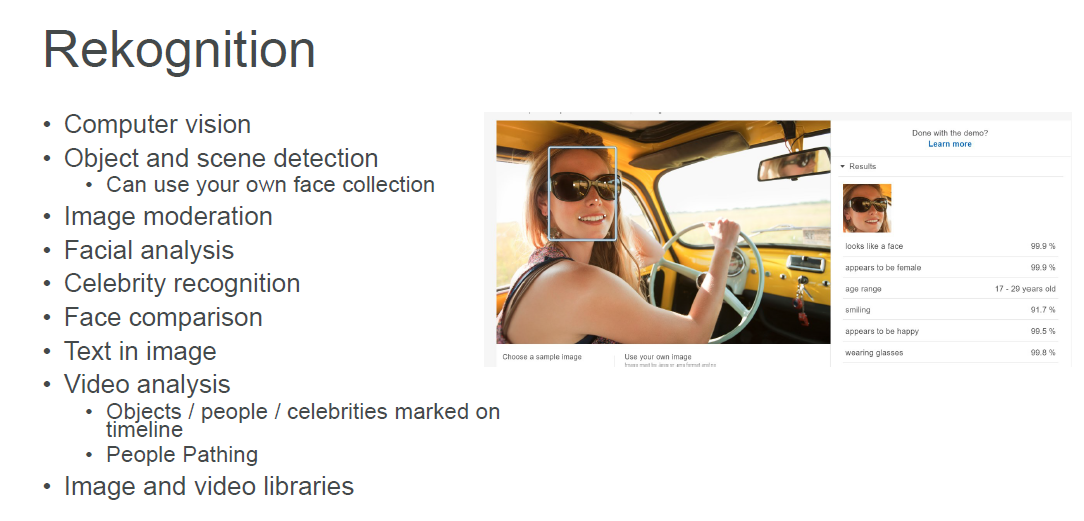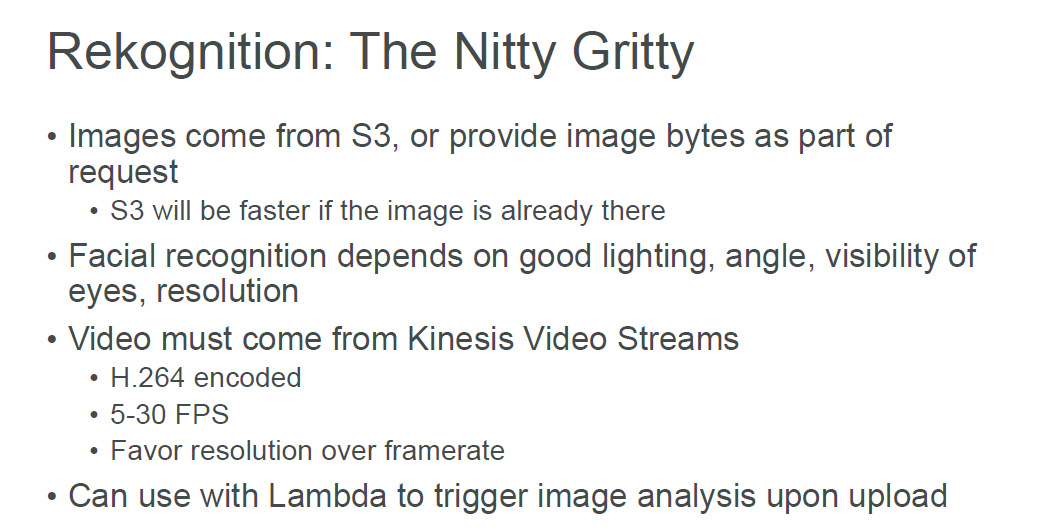AWS ML Services
AWS Machine Learning Services
Amazon Comprehend
-
Amazon Comprehend is a natural language processing (NLP) service that uses machine learning to find insights and relationships in a text.
-
Amazon Comprehend can identify the language of the text; extract key phrases, places, people, brands, or events; understand how positive or negative the text is; and automatically organize a collection of text files by topic.
-
Amazon Comprehend can also identify spam or other unwanted content in a large set of documents.
-
Amazon Comprehend can be used to analyze a wide range of text, including social media posts, websites, and documents.
| Feature | Description |
|---|---|
| Entity | identify entities such as people, places, brands, or events in a text. |
| Languages | identify the language of the text. |
| Sentiment | determine the sentiment (positive, negative, neutral) of the text. |
| Syntax | analyze the syntax of the text, including parts of speech and syntax trees. |
Amazon Translate
-
Amazon Translate is a neural machine translation service that delivers fast, high-quality, and affordable language translation.
-
Amazon Translate can translate text between languages, and it can also be used to localize websites and applications.
Amazon Rekognition
-
Amazon Rekognition is a deep learning-based image and video analysis service that can identify objects, people, text, scenes, and activities in images and videos, as well as detect any inappropriate content.
-
Amazon Rekognition can be used to analyze images and videos in a wide range of use cases, including media, advertising, and public safety.


Amazon Forecast
-
Amazon Forecast is a fully managed service that uses machine learning to deliver highly accurate forecasts.
-
Amazon Forecast can be used to forecast demand, sales, and other time-series data, and it can also be used to forecast other types of data, such as weather and financial data.
Amazon forecast Algorithms
CNN-QR (Convolutional Neural Network – Quantile Regression)
- Best for: Large datasets with hundreds of time series
- Features: Accepts related historical time series data & metadata
DeepAR+
- Model Type: Recurrent Neural Network
- Best for: Large datasets
- Features: Accepts related forward-looking time series & metadata
gProphet
- Model Type: Additive model with non-linear trends and seasonality
- Features: Suitable for various time series forecasting scenarios
NPTS (Non-Parametric Time Series)
- Best for: Sparse data
- Variants: Available for seasonal/climatological forecasts
ARIMA (Autoregressive Integrated Moving Average)
- Commonly used for: Simple datasets (<100 time series)
ETS (Exponential Smoothing)
- Commonly used for: Simple datasets (<100 time series)
AWS LEX
- Amazon Lex is a service for building conversational interfaces into any application using voice and text.
its what I used to build my senior project
Amazon Polly Overview
Amazon Polly is a powerful Neural Text-to-Speech (TTS) service that offers a wide range of voices and supports multiple languages. It provides various features to enhance the quality and customization of synthesized speech.
Neural Text-To-Speech
Amazon Polly utilizes Neural TTS technology to produce natural and lifelike speech. It offers a diverse selection of voices in different languages, enabling users to create engaging and dynamic audio content.
Lexicons
Lexicons in Amazon Polly allow users to tailor the pronunciation of specific words and phrases. This customization ensures accurate and contextually appropriate rendering of terms, such as replacing "W3C" with "World Wide Web Consortium."
SSML (Speech Synthesis Markup Language)
SSML is an integral part of Amazon Polly, providing an alternative to plain text input. This markup language gives users fine-grained control over various aspects of speech synthesis, including emphasis, pronunciation, breathing, whispering, speech rate, pitch, and pauses.
Speech Marks
Amazon Polly supports the encoding of speech marks, indicating the start and end of sentences or words in the audio stream. This feature is particularly useful for applications like lip-synching animation, where precise synchronization with speech is crucial.
Sure, here's a summary about AWS Personalize in Markdown format:
Personalize
AWS Personalize is a machine learning service provided by Amazon Web Services (AWS) that enables developers to build intelligent user personalization capabilities into their applications. It uses advanced machine learning techniques to generate personalized recommendations, personalized search results, and personalized direct marketing.
Key Features
-
Personalized Recommendations: AWS Personalize can provide personalized recommendations for various use cases, such as product recommendations, content recommendations, and personalized marketing.
-
Personalized Search: With Personalize, you can improve search relevance by incorporating user preferences and behavior into search results.
-
Personalized Direct Marketing: Personalize helps create more engaging and targeted marketing campaigns by generating personalized messaging and offers for individual users.
-
Real-time Personalization: Personalize can generate real-time personalized recommendations based on a user's current behavior and context.
-
Automatic Model Training: Personalize automatically trains and optimizes machine learning models based on your data, freeing you from the complexities of building and maintaining personalization models.
-
Integrations: Personalize integrates seamlessly with other AWS services like Amazon S3, Amazon SageMaker, and AWS Lambda, making it easy to incorporate personalization into your existing applications.
How it Works
-
Data Preparation: You provide AWS Personalize with your historical user interaction data, such as user behavior, preferences, and item metadata.
-
Model Training: Personalize automatically trains and optimizes machine learning models based on your data.
-
Real-time Inference: Your application can then send real-time user events and context to Personalize, which generates personalized recommendations or search results in response.
-
Continuous Learning: Personalize continuously updates and improves its models as it receives more data from your application, providing increasingly accurate personalization over time.
AWS Personalize simplifies the process of building and deploying personalization capabilities, allowing developers to focus on their core application while providing their users with highly personalized experiences.
Amazon Textract
- Amazon Textract is a machine learning service that automatically extracts text and data from scanned documents, forms, and tables.
Amazon TorchServe and Neuron
-
Amazon TorchServe is an open-source model serving library for PyTorch models, and Amazon Neuron is a hardware-accelerated inference engine for AWS Inferentia-based EC2 instances.
-
Amazon Neuron is a hardware-accelerated inference engine for AWS Inferentia-based EC2 instances. It is designed to deliver high-performance, low-latency inference for deep learning models in production.
Amazon Panorama
-
Amazon Panorama is a machine learning appliance and software development kit (SDK) that allows you to add computer vision (CV) to existing on-premises cameras to make them "smart" and capable of running computer vision models at the edge.
AWS DeepComposer
- AWS DeepComposer is a machine learning-enabled musical keyboard and a cloud-based service that allows developers to create original music using machine learning models.
Amazon CodeGuru
- Amazon CodeGuru is a machine learning-based service that provides intelligent recommendations for improving code quality and identifying potential performance issues in your applications.
Find more information on
- Architecting-on-AWSArchitecting-on-AWSDay 1: AWS Security and Identity Management Create Role Trust Policy: The trust policy defines who or what can assume the role. It outlines the entities that are allowed to take on the permissions associated with the role. This can include AWS services, users, accounts, or even external identities Permissions Policy: The permissions policy specifies what actions and resources the role is allowed to access or manipulate. It defines the boundaries of the role's capabilities within AWS. Permissi